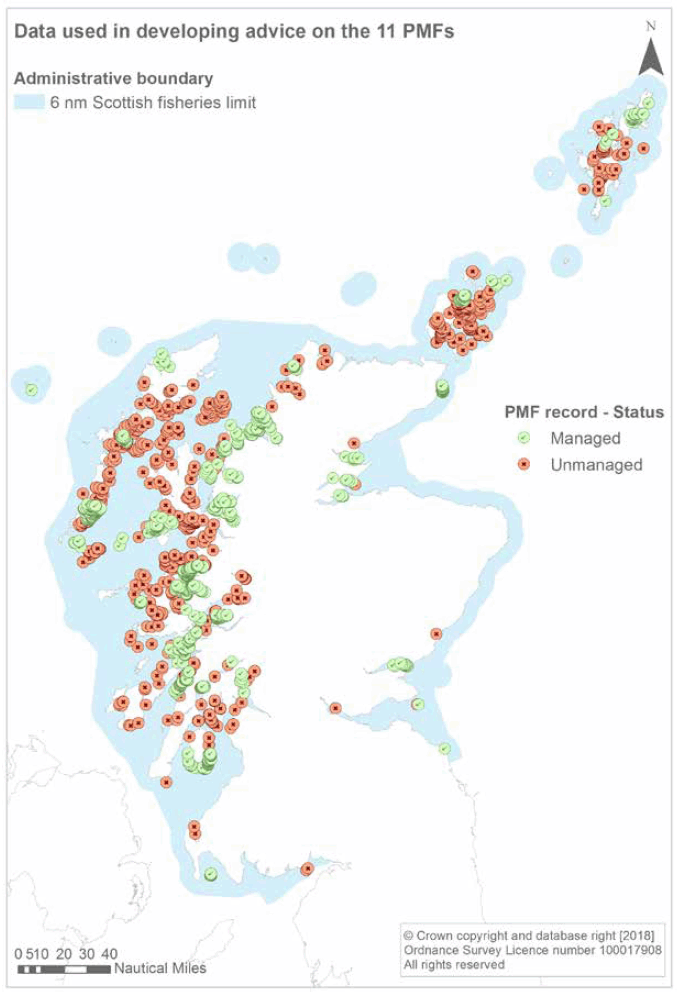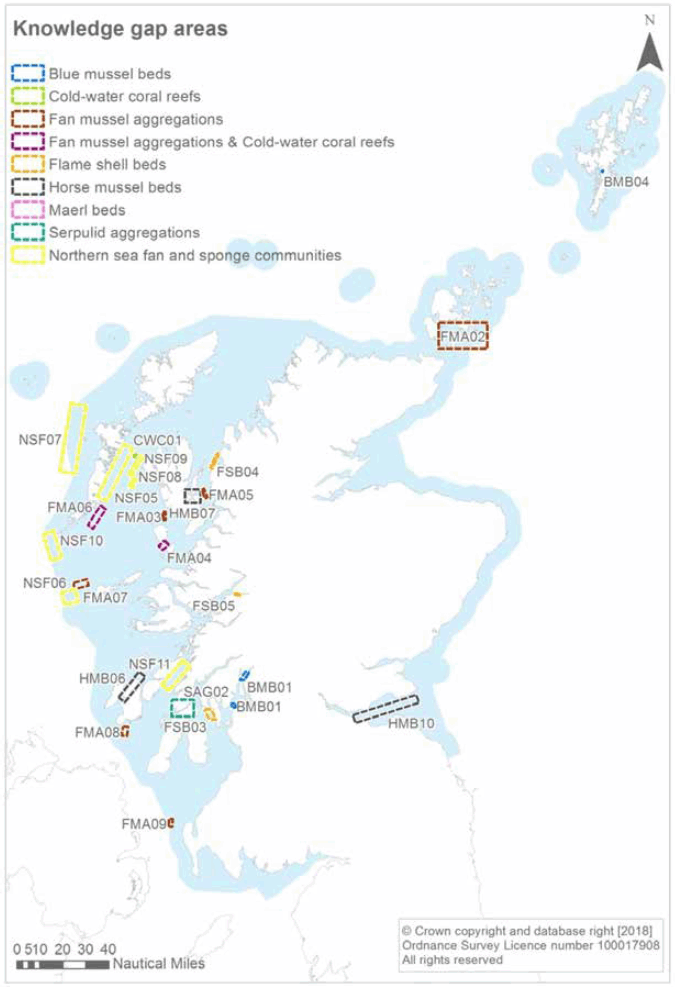Improving protection given to Priority Marine Features outside the Marine Protected Area network
A consultation seeking views on the scope of the project to improve protection given to PMFs outside the MPA network.
SNH advice
Scottish Natural Heritage has provided advice documents for each of the 11 habitats and species. These are published on the Citizen Space page and provide a range of information about each of the habitats and species:
- Ecology, distribution, status and sensitivity - what the feature is, where it occurs and the case for protection
- Ecosystem Services – The benefits they provide to society. There is further information on this in Annex C.
- Existing protection – The MPA network and the extent to which existing and proposed fisheries management measures protect the habitat or species in question.
- Assessment against NMP General Policy 9 – general advice and recommendations on whether additional fisheries management should be considered to ensure there is no significant impact on national status of the PMF. This includes a description of areas for management consideration.
- Knowledge-gap areas –Areas where some evidence exists regarding presence of the habitat or species, but is insufficient to determine whether fisheries management is necessary.
- Data confidence and reference – details of the underpinning evidence-base
- Overview map – showing the distribution of managed and unmanaged records, and areas for management consideration.
The evidence and advice in these documents are fundamental to the Sustainability Appraisal. Therefore this consultation seeks views on these advice documents.
Areas for management consideration
Areas for management consideration represent advice from SNH that indicates where attention should be focused to ensure that a significant impact on the national status of these PMFs is avoided, as a result of the use of bottom contacting mobile fishing gear. However, SNH is not recommending that the entirety of these areas be closed to bottom contacting mobile fishing gear. These areas will be used as a basis for discussion on management. A series of steps were undertaken to identify areas for management consideration.
Firstly, the PMF records were sorted into three categories as described below.
No possible overlap with bottom-contacting fishing gear - intertidal records and records in subtidal areas where it would not be possible to use bottom contacting fishing gear (e.g. due to shallow water depth, narrow channel access etc.). These PMF records are shown in the advice documents. These records comprise seagrass beds, blue mussel beds, native oysters and a small number of maerl bed records. Risk to these features from other activities will continue to be managed through existing licensing processes.
Managed - subtidal PMF records within the MPA network and/or fisheries management areas where bottom contacting mobile fishing gears currently are, or are proposed to be, prohibited year round.
Unmanaged - subtidal PMF records not within the MPA network and/or fisheries management areas where bottom contacting mobile fishing gears currently are, or are not proposed to be, prohibited year round.
The overall distribution of the managed and unmanaged records of the 11 habitats and species used in this review is shown in figure 1.
The next step was to consider whether the protection afforded by existing management would ensure no significant impact on national status for each of the habitats and species. This involved assessing the distribution and extent of the managed and unmanaged records against information on the ecology, distribution, status and sensitivity of each of the habitats and species. Where SNH considered that additional management might be required the habitats and species records in proximity to each other were grouped and described as areas for management consideration. Table 1 and figure 2 show that there is considerable overlap in areas identified for the different habitats and species for management consideration.
Questions
3. Do you have any comments on the approach taken by SNH to develop the advice?
4. Do you have any comments on the specific advice for any of the PMFs?
5. Do you have any comments in the identification of areas for management consideration?

Figure 1. Distribution of managed and unmanaged records used in this review

Figure 2. Areas for management consideration
Table 1. Advice from SNH on areas for management consideration
| PMF | Areas for management consideration |
|---|---|
| Blue mussel beds | 2 Solway Firth - BMB02; Dornoch Firth - BMB03 |
| Cold-water coral reefs | - |
| Fan mussel aggregations | 1 South-east of Muck - FMA01 |
| Flame shell beds | 2 Scapa Flow - FSB01; Port Appin - FSB02 |
| Horse mussel beds | 7 Orkney - HMB01; Shetland - HMB02; Lochs Linnhe, Leven and Eil - HMB03; Craignish to Gigha - HMB04; Loch Long (Upper) - HMB05; Dornoch Firth - HMB08; Gourock - HMB09 |
| Maerl beds & Maerl or coarse shell gravel with burrowing sea cucumbers # | 13 Clyde # - MBC01; Islay and Jura - MBC02; Skye # - MBC03; Uists # - MBC04; Lewis & Harris # - MBC05; Inner Sound # - MBC06; Orkney # - MBC07; Mallaig to Mull # - MBC08; Kylesku to Eriboll # - MBC09; North-west Mull # - MBC10; Shetland (Lunning Sound) - MBC11; Shetland (Wadbister) - MBC12; Shetland (Papa (North)) - MBC13 |
| Native oysters | 1 West coast of Mull and Ulva - OST01 |
| Northern sea fan and sponge communities | 4 Shiant East Bank - NSF01; Little Minch - NSF02; Sea of Hebrides (Mingulay 4) - NSF03; South of Eigg - NSF04 |
| Seagrass beds | 8 Orkney - SGB01; Sound of Harris - SGB02; South Skye - SGB03; SW Shetland - SGB04; Loch Indaal (Islay) - SGB05; Gairloch - SGB06; Enard Bay and Edrachillis Bay - SGB07; Ulva - SGB08 |
| Serpulid aggregations | 1 Loch Ailort - SAG01 |
Knowledge gaps
SNH has also identified knowledge gaps. These are areas with PMF records (or potentially suitable habitat from modelling studies) in which additional survey work would be required to confirm the current presence and/or status of the feature. This would be necessary before determining whether further discussion on management is required. Within the PMF advice a description of these knowledge gap areas is provided. For convenience they are listed in Table 2 and shown in the map in Figure 3. These areas may help target future survey and monitoring activity.
Table 2. Advice from SNH on knowledge gaps
| PMF | Knowledge gap areas identified |
|---|---|
| Blue mussel beds | 2 Inverkip and Loch Long - BMB01; Whiteness Voe - BMB04 |
| Cold-water coral reefs | 3 NW Skye - Coral - CWC01; South of Rum - FMA04; East of Barra - FMA06 |
| Fan mussel aggregations | 8 Scapa Flow & Copinsay - FMA02; Small Isles - FMA03; South of Rum - FMA04; Southern Inner Sound - FMA05; East of Barra - FMA06; NW Tiree - FMA07; South of Islay - FMA08; Off Clyde Sea Sill - FMA09 |
| Flame shell beds | 3 Inchmarnock - FSB03; Inner Sound - FSB04; Loch Leven - FSB05 |
| Horse mussel beds | 3 Islay - HMB06; East Skye - HMB07; Firth of Forth - HMB10 |
| Maerl beds & Maerl or coarse shell gravel with burrowing sea cucumbers # | - |
| Native oysters | REDACTED - 5 areas identified but not mapped - in accordance with SNH sensitive species policy (areas are finer resolution than permissible 20 km grid). |
| Northern sea fan and sponge communities | 7 East of Uists - NSF05; West of Tiree - NSF06; West of the Hebrides - NSF07; NW Skye - NSF08; West of Skye - NSF09; SW Barra Head - NSF10; Sound of Jura - NSF11 |
| Seagrass beds | - |
| Serpulid aggregations | 1 West Loch Tarbert - SAG02 |

Figure 3. Knowledge gap areas
Contact
- Marine Conservation team
0131 244 1617
There is a problem
Thanks for your feedback